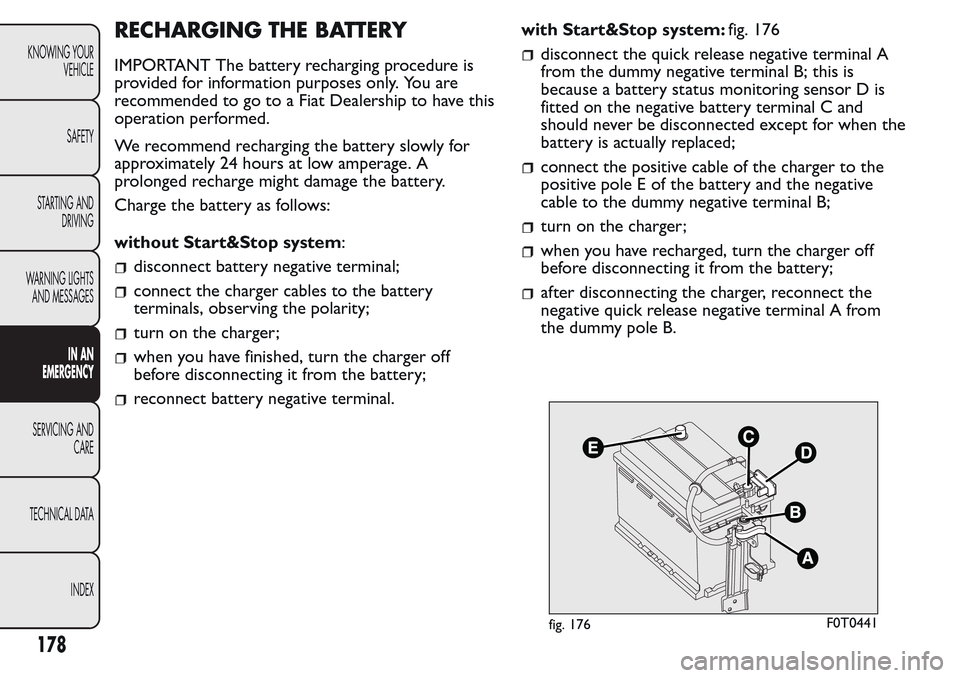2017 FIAT QUBO charging
[x] Cancel search: chargingPage 57 of 260

FRONT POWER SOCKET (12V)
This is located on the central unit fig. 51 and only
works with the key at MAR.
Lift cap B to use fig. 51.
CIGARETTE LIGHTER
(for versions/markets, where provided)
The cigarette lighter is positioned on the central
console. Press button A fig. 51 to switch on the cigar
lighter when the ignition key is turned to MAR.
After a few seconds the button goes back to
its initial position and the cigar lighter is ready for
use.
IMPORTANT Always check that the cigarette lighter
is switched off.WARNING
The cigar lighter gets extremely hot .
Handle it carefully and make sure
children don't touch it : risk of fire and/or
burning.
USB PORT
(for versions/markets, where provided)
The USB socket A fig. 52 is located in the central
console in place of the cigar lighter and can be used
only as a charging source for external devices.
ASHTRAY
(for versions/markets, where provided)
The ashtray is a removable spring-loaded plastic box
that can be fitted into the cup/can holders on the
central console fig. 53.
fig. 51F0T0454fig. 52F0T0930
53
KNOWING YOUR
VEHICLE
SAFETY
STARTING AND
DRIVING
WARNING LIGHTS
AND MESSAGES
IN AN EMERGENCY
SERVICING AND
CARE
TECHNICAL DATA
INDEX
Page 182 of 260

RECHARGING THE BATTERY
IMPORTANT The battery recharging procedure is
provided for information purposes only. You are
recommended to go to a Fiat Dealership to have this
operation performed.
We recommend recharging the battery slowly for
approximately 24 hours at low amperage. A
prolonged recharge might damage the battery.
Charge the battery as follows:
without Start&Stop system:
disconnect battery negative terminal;
connect the charger cables to the battery
terminals, observing the polarity;
turn on the charger;
when you have finished, turn the charger off
before disconnecting it from the battery;
reconnect battery negative terminal.with Start&Stop system:fig. 176
disconnect the quick release negative terminal A
from the dummy negative terminal B; this is
because a battery status monitoring sensor D is
fitted on the negative battery terminal C and
should never be disconnected except for when the
battery is actually replaced;
connect the positive cable of the charger to the
positive pole E of the battery and the negative
cable to the dummy negative terminal B;
turn on the charger;
when you have recharged, turn the charger off
before disconnecting it from the battery;
after disconnecting the charger, reconnect the
negative quick release negative terminal A from
the dummy pole B.
fig. 176F0T0441
178
KNOWING YOUR
VEHICLE
SAFETY
STARTING AND
DRIVING
WARNING LIGHTS
AND MESSAGES
IN AN
EMERGENCY
SERVICING AND
CARE
TECHNICAL DATA
INDEX
Page 183 of 260

with Start&Stop (RADSOK) system:fig. 177
disconnect the connector A (by pressing button
B) from IBS sensor C for monitoring the status
of the battery installed on the negative pole D of
the battery itself;
connect the positive cable to the positive battery
terminal E and the negative terminal to the IBS
sensor F as shown in fig. 177;
turn on the charger;
switch the charger off after recharging;
after having disconnected the charger, reconnect
connector A to IBS sensor C as shown in fig. 177.
WARNING
Battery fluid is poisonous and corrosive:
avoid contact with your skin and eyes.
The battery must be recharged in a ventilated
place away from naked flames or possible
sources of sparks to avoid the risk of explosion
and fire.
WARNING
Do not tr y to recharge a frozen batter y;
defrost it first to prevent the risk of
explosion. If the battery was frozen, have it
inspected by specialised personnel before
recharging to check that the internal elements
are not damaged and that the casing is not
cracked, which could cause poisonous, corrosive
acid to leak.
fig. 177F0T0442
179
KNOWING YOUR
VEHICLE
SAFETY
STARTING AND
DRIVING
WARNING LIGHTS
AND MESSAGES
IN AN
EMERGENCY
SERVICING AND
CARE
TECHNICAL DATA
INDEX
Page 253 of 260

INDEX
Handbrake .................................. 125
ABS ................................................ 71
ABS (fault warning light) ......... 136
ABS fault warning light ............. 136
Air bag (fault warning light) ..... 134
Air bag fault warning light ........ 134
Air cleaner ................................... 197
Airbags (general warnings) ...... 119
Alarm ............................................. 10
Alarm (warning light) ................ 141
Alarm fault warning light ......... 141
Arrangement possibilities
for Universal Isofix child
restraint system on seats
of vehicle.................................... 111
Arrangements for dealing
with the vehicle at the end
of its life .................................... 237
Ashtray .......................................... 53
ASR system .................................. 75
Battery
– Replacement .......................... 197
Battery (low charge warning
light) ........................................... 135
Battery (recharging) .................. 178
Body– Advice for preserving the
bodywork ............................... 204
– Protection from
atmospheric elements......... 203
– Vehicle body and
underbody guarantee .......... 204
body paintwork
identification plate ................... 209
Bodywork version ..................... 210
Bonnet
– Closing ..................................... 68
– Opening ................................... 67
Boot light ..................................... 169
Bottle replacement .................... 156
Brake fluid.................................... 195
Brake fluid (warning light)........ 133
Brake fluid/handbrake
warning light.............................. 134
Brake lights (changing a
bulb) ............................................ 163
Brake pad wear (warning
light) ............................................ 143
Brake pad wear warning
light ............................................. 143
Brakes
– features ................................... 214
Brakes (pad wear warning
light) ............................................ 143Break-in attempt warning
light ............................................. 141
Bulbs
– types of bulbs ........................ 158
Bump starting ............................. 147
Carrying children safely
– Arrangement possibilities
for child restraint
systems ................................... 108
– Child restraint systems ....... 103
– Safety regulations ................. 112
Ceiling light with movable
lens (changing a bulb).............. 166
Ceiling lights................................. 48
Central and side vents ............... 36
Changing a bulb .......................... 157
Changing a wheel ....................... 147
Changing an exterior bulb ....... 160
Changing an interior bulb ........ 166
Changing battery - key with
remote control.......................... 8
Chassis marking.......................... 209
Checking levels ........................... 190
Cigarette lighter .......................... 53
Clutch ........................................... 213
CO2 emissions ........................... 235
Conditions of use ...................... 129KNOWING YOUR
VEHICLE
SAFETY
STARTING AND
DRIVING
WARNING LIGHTS
AND MESSAGES
IN AN EMERGENCY
SERVICING AND
CARE
TECHNICAL DATA
INDEX